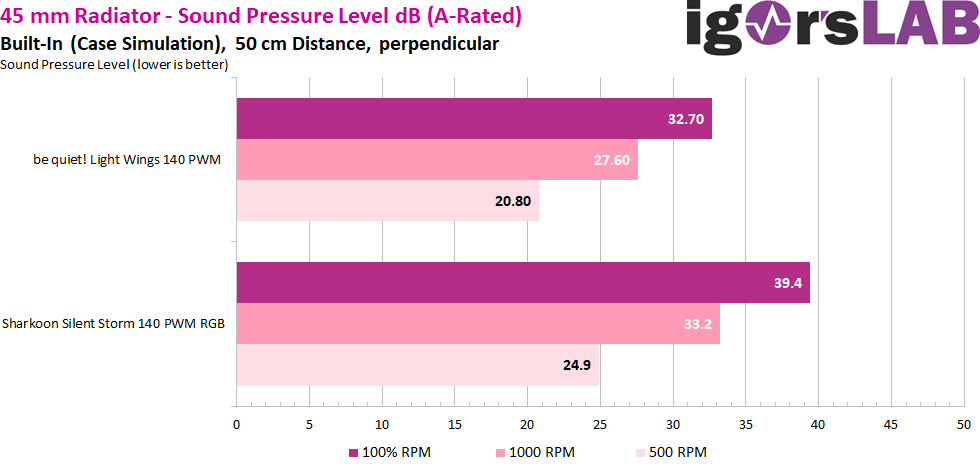If you compare the absolute values with those of the reference, the Sharkoon Silent Storm 120 mm still cuts a good figure throughout. It is a bit louder, but it also creates more throughput and, above all, significantly more static pressure for radiator operation. At the end, we added a very complex measurement in 5-cfm steps, which shows the sound pressure level as a curve over the entire speed range in relation to the volume flow. The fan also scores very well in this respect and even manages a virtual tie in the direct ratio of sound pressure level and volume flow. So much in advance, and it shows that speed-related measurements don’t really have to be objective for a verdict.
Sound comparison (recording) at 100% speeds
As just mentioned, the subjective sensation is a somewhat clearer noise from the motor and the rotor blades, which is of course also due to the different speeds. The Sharkoon Silent Storm 120 mm produces a bit more motor noise, whereas already the reference fan others can be called loud.
Sharkoon Silent Storm 140 mm
Be Quiet! Light Wings 140 mm
Sound comparison (recording) at 1000 rpm
Subjectively, the soundstage is almost the same, you can really leave it like that. Only in open mode is the Sharkoon Silent Storm 120 mm a bit louder at 1000 rpm, since it works closer to its upper speed limit. However, if you mount it on a radiator, it even gets quieter than the reference (graphics above).
Sharkoon Silent Storm 140 mm
Be Quiet! Light Wings 140 mm
Total speed range (440 to 1400 rpm)
Before I will explain the frequency analysis of the recorded spectrum to you, there is the dreaded “station search”, where we will play through the fan operation from the lowest to the highest speed. And please don’t be alarmed, we have amplified the whole thing a bit so you can hear it better. So don’t set your listening level too high, though – this time it’s not particularly extreme. A very slight humming can be perceived in parts, but the whole thing is hardly noticeable. You have to listen very carefully.
If the speakers have survived the whole thing up to this point, we’ll now go into more detail.
Frequency spectrum in the housing
Let’s look at the frequency analyses of all measurements and all three tested speeds. The graphs speak for themselves, as you can also see a small lower-frequency peak of the engine at full speed quite clearly:








































45 Antworten
Kommentar
Lade neue Kommentare
Veteran
Urgestein
Mitglied
Veteran
Urgestein
Veteran
Veteran
Mitglied
Urgestein
1
Veteran
Urgestein
Urgestein
Urgestein
Urgestein
Mitglied
Alle Kommentare lesen unter igor´sLAB Community →